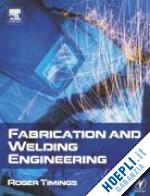Chapter 1 Health and safety1.1 Health safety and the law1.2 Employers' responsibilities1.3 Employees' responsibilities1.4 Electrical Hazards1.5 Fire fighting1.6 Fire precautions and prevention1.7 Accidents1.8 First aid1.9 Personal protection1.10 Hazards in the workplace1.11 Manual Lifting1.12 Mechanical lifting equipment1.13 Use of lifting equipment1.14 Accessories for lifting gear1.15 Useful knots for fibre ropes1.16 Inspection (lifting equipment)1.17 Oxy-acetylene welding1.18 Arc-welding equipment (mains operated)1.19 Working on siteExercisesChapter 2 Personal development2.1 Basic relationships2.2 Relationship with managers, supervisors and instructors2.3 Attitude and behaviour2.4 Implementing company policy2.5 Creating and maintaining effective relationships with othersExercisesChapter 3 Engineering materials and heat treatments3.1 States of matter3.2 Properties of materials3.3 Classification of materials3.4 Ferrous metals (plain carbon steels)3.5 Ferrous metals (alloy steels)3.6 Ferrous metals (cast irons)3.7 Abbreviations3.8 Non-ferrous metals and alloys3.9 The identification of metals3.10 Non-metals (natural)3.11 Non-metals (synthetic)3.12 Forms of supply3.13 Heat treatment processes (introduction)3.14 Heat treatment processes (safety)3.15 The heat treatment of plain carbon steels3.16 The heat treatment of non-ferrous metals and alloys3.17 Heat treatment furnaces3.18 Temperature measurement3.19 Atmospheric controlExercisesChapter 4 Using and communicating technical information4.1 Selection of information sources4.2 Interpretation of information (graphical)4.3 Interpretation of information (tables, charts and schedules)4.4 Evaluating engineering information4.5 Recording and processing engineering information4.6 Methods of record keeping4.7 Communications (miscellaneous)4.8 Engineering drawing (introduction)4.9 First angle orthographic drawing4.10 Third angle orthographic drawing4.11 Conventions4.12 Redundant views4.13 Dimensioning4.14 Welding symbols4.15 The development of surfaces4.16 Interpenetration4.17 Pictorial viewsExercisesChapter 5 Measuring and making out5.1 Introduction5.2 Linear measurement5.3 Angular measurement5.4 Correct use of measuring equipment5.5 Marking out equipment (tools for making lines)5.6 Marking out equipment (tools for providing guidance)5.7 Marking out equipment (tools for providing support)5.8 Techniques for marking out5.9 The need for templates5.10 The manufacture of templates5.12 Condition and care of equipmentExercisesChapter 6 Material removal6.1 Cutting tool principles6.2 The application of basic cutting tool angles to hand tools6.3 Drilling, drilling machines and routing6.4 Shearing sheet metal6.5 Portable power tools6.6 Blanking (stamping and piercing)6.7 Flame cuttingExercisesChapter 7 Sheet and plate metalwork7.1 Sheet and plate metalwork (introduction)7.2 Roll-bending sheet metal and plate7.3 Flow forming sheet metal7.4 The principles of metal spinning7.5 Swaging sheet metal7.6 Basic fabrication proceduresExercisesChapter 8 Structural steelwork and pipework8.1 Rolled steel sections8.2 Typical structural steel connection and assemblies8.3 Trusses and lattice frames8.4 Web stiffeners8.5 Fabricated lightweight beams8.6 Castellated beams8.7 Pipework (setting out bends)8.8 Pipe bending8.9 Pipe fittingExercisesChapter 9 Joining processes (mechanical connections)9.1 Mechanical connections (threaded)9.2 Hand reamers and reaming9.3 Riveted joints9.4 Pop Diveting9.5 Self secured joints9.6 Folding and jointing allowance9.7 The Pittsburgh lockExercisesChapter 10 Joining processes (soldering, brazing and braze welding10.1 Soft soldering10.2 Soft-soldered joints using lead-free solders10.3 Hard soldering (brazing)10.4 Aluminium brazing10.5 Types of brazed joints10.6 Braze-weldingExercisesChapter 11 Joining processes (welding)11.1 Fusion welding11.2 Oxy-acetylene welding11.3 Manual metal-arc welding11.4 Workshop testing of welds11.5 Miscellaneous fusion welding processes11.6 Workholding devices for fusion welding11.7 Resistance welding11.8 Further welding processesExercisesChapter 12 Composite fabrication processes and adhesive bonding12.1 Introduction12.2 Lamination12.3 Fibre reinforcement12.4 Particle reinforcement12.5 The manipulation of fabrication of polymers (plastics)12.6 Adhesive bonding12.7 Adhesive bonding of metalsExercisesAppendix AIndex











